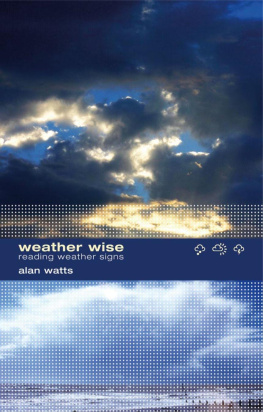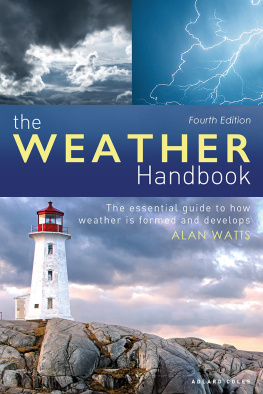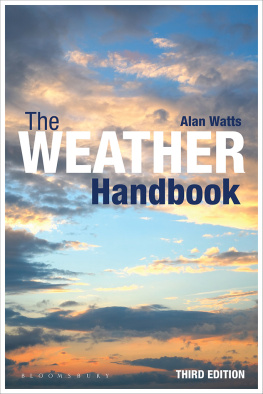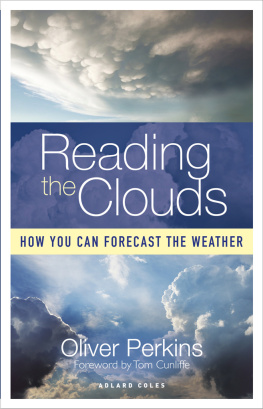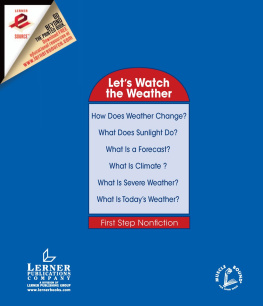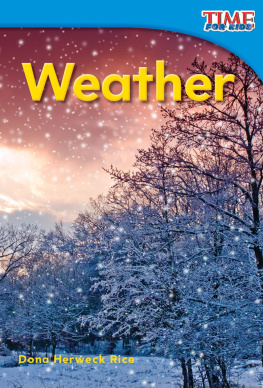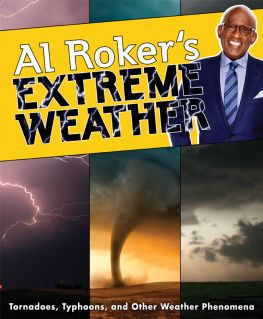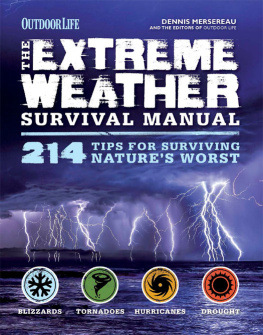

This is a weather book with a difference. It sets out to answer, in simple terms, the questions that so many people ask about the weather. Why is the sky blue? Why does it rain? What happens in the clouds and why dont all clouds rain? Why does the wind get up with the day and die down at night? How do I tell if bad weather is coming? How do I reduce the risk of being struck by lightning? What should I beware of when I leave the lowlands and walk or climb higher?
I have liberally illustrated these chapters with photographs from the collection I have made over the years. They have been chosen not only because they illustrate aspects of the weather but also because they are, in many cases, photogenic. The sky and weather phenomena generally are wonderful subjects for the photographer, but the sky changes from moment to moment, and having your camera with you at all times will enable you to capture truly beautiful skies or fascinating phenomena.
After a lifetime spent trying to explain weather to people who are not, and never wish to be, meteorologists, I have had many questions fired at me. In this book I have tried to answer some of these questions as well as many others.
A previous book of mine, Instant Weather Forecasting, is a kind of ready-reckoner for weather conditions that will usually accompany the 24 specially selected sky pictures. I wrote it to suggest what each characteristic sky might mean for the coming hours. Weather Wise is different. It gives more explanations and provides examples of the weather experienced in the tem perate latitudes of the northern hemisphere.
For all those who live in climes to which this book applies, I hope you will find answers to what you want to know between these pages. If you want something more in depth, then try The Weather Handbook which I wrote to give the interested layman an insight into how the weather behaves.
Alan Watts
The seasons follow the sun so we will start where many ancient religions started their year at the winter solstice. By the calendar, this is on or about 22 December. Ancient priests observing sunrise would, during December, have seen sunrise creep slowly further and further southwards day by day until it came to a standstill for several days around 22 December. On or around 25 December there would be a glimmer of movement back towards the north again. The Celtic tradition held that the sun was reborn at this time.
Gradually the suns risings move back further and further northwards until it is rising due east at the spring equinox (21 March). However, the weather of winter and early spring lags behind the sun. The sun may get higher but the winds remain cold and the days often get colder. For the first months of the year: As the days lengthen the cold strengthens.
Photo 1 The typical sky of spring big cumulus clouds, showers and blossom. The air is often cool and unstable.
Photo 2 What we would all like in summer: fair-weather skies, balmy winds and delightful surroundings.
The sea, which has been getting colder since September, continues to do so, and this often governs the temperature of the air, so that January and February are usually the coldest months. In the worst years, March is not much better it may even be colder than the previous months and spring is slow to start. Yet it is a very unusual year if spring is not bursting forth by the spring equinox.
Late spring and early summer see the sunrise moving northwards day by day but slowing down as the summer solstice approaches. Sunrise observers see the sun come up more and more closely to the furthest northerly point it will achieve. Its sunrise position then stands still for several days around 21 June before it slowly begins to move back south through the autumnal equinox until it again stands still at the next winter solstice. The summer solstice is often referred to as midsummer but in the northern hemisphere we know that the best summer weather is yet to come. This yearly rhythm of the sun controls the amount of heat a hemisphere acquires, but it is the sea that absorbs that heat in depth, and this means that it is late August or early September before the sea is at its warmest. The sea is usually coldest in March and early boaters should beware.
In the temperate latitudes cold winds from northern seas and polar regions keep spring cold, showery and often blustery. Equally it is the warmest sea temperatures of the year that lead to autumn being the season of mists and mellow fruitfulness. Summer is when the bad weather systems migrate northwards leaving central and southern temperate latitudes warm and usually with light winds. Not every time, though.
It was high summer, August 1979, when, in light winds, a great fleet of yachts left the Solent in southern England to take part in the biennial Fastnet Yacht Race. The race is so-named because the turning mark is the Fastnet Rock off southern Ireland and the course carries the fleet into very exposed waters. So when an unprecedented vicious storm blew up, with most yachts strung out between the Scilly Isles and Fastnet, what should have been a happy competitive event turned into a disaster that claimed the lives of 15 crew and led to 20 yachts being abandoned.
There are sometimes strong winds in this area in August, but only very occasionally do storms more reminiscent of January come along. It was 17 years (1956) since a similar kind of storm in the English Channel had prompted the Royal Ocean Racing Club to invoke an enquiry into weather that decimated an ocean race. When you realise how this area, the centre of English yachting, is alive with sails through the summer, it is evident that big storms are very rare here.
Yet they do occur and there is no way of knowing if another might turn up. The changeable weather of the latitudes surrounding 50N never allows people to be complacent. January may be benign and almost warm, while it snows (on rare occasions) in June. Luckily there are very good weather forecasting services these days and people who are not forewarned have only themselves to blame.
Why are there seasons?
Seasons are easier to understand if you examine a simple model. Take a dinner plate whose rim represents the path the Earth takes as it orbits the sun. Raise it a bit a thick book is useful and get a ball (eg an orange) to represent the Earth. Stick a knitting needle through the ball to represent the axis about which the Earth spins (). Draw a line round the ball to represent the Equator.
Incline the Earths axis as in ).
Midwinter in the northern hemisphere (NH) is at A. The suns rays strike the NH obliquely and so less heat is absorbed by the hemisphere and it is coldest. Conversely it is midsummer in the southern hemisphere (SH) and the sun is higher in the sky. Move round a quarter of the orbit and it is NH spring. Now all the places on the same latitude see the sun equally. It is the spring equinox and everywhere the sun rises due east and sets due west. It does so at 6 am and 6 pm local solar time (time measured from midday when the sun crosses the meridian).
Next page
